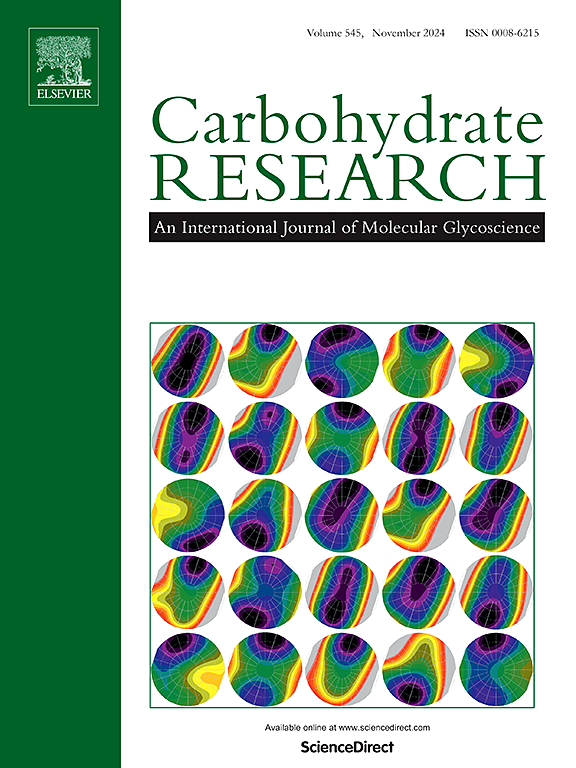有机催化合成2-脱氧糖基叠氮化物:在1,2,3-三唑连接的2-脱氧糖苷中的应用。
IF 2.5
3区 化学
Q3 BIOCHEMISTRY & MOLECULAR BIOLOGY
引用次数: 0
摘要
与从糖基生成2-脱氧糖苷的催化反应的显著发展相比,直接生成2-脱氧糖苷基叠氮化物的合成方法较少探索。因此,尽管c2 -羟基化糖基叠氮化物通过糖多样化得到了突出的应用,但在涉及n链修饰糖的研究中,2-脱氧糖部分用于生物相容性材料和疗法的进展受到了限制。本文报道了以n -氟苯磺酰亚胺(NFSI)为催化剂,TEMPO为辅助催化剂,在1,2- dce中有机催化合成2-脱氧糖基叠氮化物的方法。通过系统地改变反应参数来确定合适的反应条件,并随后将不同保护的糖醛用于合成糖基叠氮化物。该反应不产生费里尔重排副产物,具有α-选择性。并对叠氮化物进行了“咔嗒”反应合成2-脱氧糖链1,2,3-三唑衍生物的实验。一些具有芳族和脂肪族取代的炔因此与叠氮化物反应得到了一类新的2-脱氧糖苷。本文章由计算机程序翻译,如有差异,请以英文原文为准。

Organocatalyzed synthesis of 2-deoxyglycosyl azides: Application in 1,2,3-triazole linked 2-deoxyglycosides
In comparison to the significant development of catalysed reactions for the formation of 2-deoxyglycoside from glycals, synthetic methods for the direct formation of 2-deoxyglycosyl azides are less explored. Consequently, the use of the 2-deoxy sugar moieties in the studies involving N-linked modified sugars for the advancements in bio-compatible materials and therapeutics are restricted despite the C2-hydroxylated glycosyl azides finding prominent application through glycodiversifications. We herein report an organocatalysed synthesis of 2-deoxyglycosyl azides from glycals using N-Fluorobezenesulfonimide (NFSI) as a catalyst and TEMPO as a co-catalyst in 1,2-DCE. The appropriate reaction conditions were determined by systematically varying reaction parameters and subsequently employed to the synthesis of glycosyl azides from differently protected glycals. The reactions did not suffer from Ferrier rearrangement by-product and was observed to be essentially α-selective in nature. Furthermore, the azides have been tested for the synthesis of 2-deoxy sugar linked 1,2,3-triazole derivatives using “click” reaction. Several alkynes with aromatic and aliphatic substitutions have been thus reacted with the azides to obtain a new class of 2-deoxyglycosides.
求助全文
通过发布文献求助,成功后即可免费获取论文全文。
去求助
来源期刊

Carbohydrate Research
化学-生化与分子生物学
CiteScore
5.00
自引率
3.20%
发文量
183
审稿时长
3.6 weeks
期刊介绍:
Carbohydrate Research publishes reports of original research in the following areas of carbohydrate science: action of enzymes, analytical chemistry, biochemistry (biosynthesis, degradation, structural and functional biochemistry, conformation, molecular recognition, enzyme mechanisms, carbohydrate-processing enzymes, including glycosidases and glycosyltransferases), chemical synthesis, isolation of natural products, physicochemical studies, reactions and their mechanisms, the study of structures and stereochemistry, and technological aspects.
Papers on polysaccharides should have a "molecular" component; that is a paper on new or modified polysaccharides should include structural information and characterization in addition to the usual studies of rheological properties and the like. A paper on a new, naturally occurring polysaccharide should include structural information, defining monosaccharide components and linkage sequence.
Papers devoted wholly or partly to X-ray crystallographic studies, or to computational aspects (molecular mechanics or molecular orbital calculations, simulations via molecular dynamics), will be considered if they meet certain criteria. For computational papers the requirements are that the methods used be specified in sufficient detail to permit replication of the results, and that the conclusions be shown to have relevance to experimental observations - the authors'' own data or data from the literature. Specific directions for the presentation of X-ray data are given below under Results and "discussion".
 求助内容:
求助内容: 应助结果提醒方式:
应助结果提醒方式:


